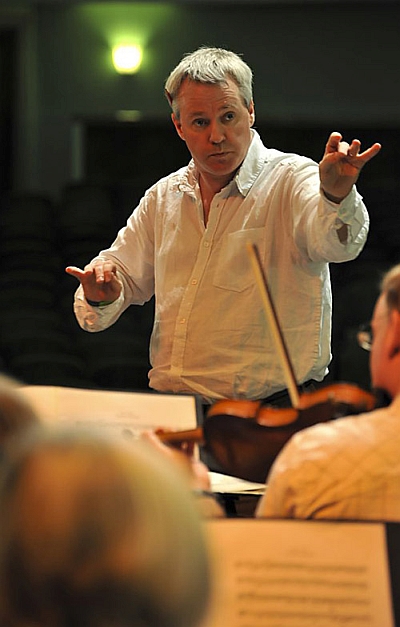 United Kingdom Mendelssohn, Edward Loder – An Evening of Gothic Entertainment: Soloists, Bath Philharmonia/Jason Thornton (conductor), The Assembly Rooms, Bath, England 15.10.15 (RJW)
United Kingdom Mendelssohn, Edward Loder – An Evening of Gothic Entertainment: Soloists, Bath Philharmonia/Jason Thornton (conductor), The Assembly Rooms, Bath, England 15.10.15 (RJW)

Mendelssohn: Hebrides Overture (Fingal’s Cave) Op. 26 (1830)
Mendelssohn: Violin Concerto in E Minor Op. 64 (1844)
Edward Loder: Raymond and Agnes, opera (excerpts) (1855)
Soloists:
Charlie Siem (violin)
Agnes: Donna Lennard (soprano)
Baron: Joe Corbett (baritone)
Raymond: John Colwyn Gyaentey (tenor)
Narration: ‘Mr & Mrs Loder of Bath’
The main attraction of the Bath Loder Festival was this concert which featured Mendelssohn and excerpts from Loder’s opera, Raymond and Agnes. The two composers provide a good combination of programme with music of a similar genre. The Hebrides Overture was in fact premièred in New York at their Philharmonic Society with George Loder conducting.
A vibrant reading of the Hebrides Overture that opened the programme was played with energy and style, the ebb and flow of dynamics matching that of imaginary waves lashing that remote corner of the British Isles. The piece is so well known that one doesn’t always appreciate the cleverly descriptive orchestration that makes it so memorable.
A magnificent performance of the Mende3lssohn Violin Concerto was given by Norwegian, Charlie Siem, a violinist who has been in contact with music since the age of three. He is currently a visiting professor at Leeds College of Music and is clearly at home with this repertoire. He was well supported by the conducting of Jason Thornton, who anticipated the lengths of fioritura with excellent accuracy of blending.
The highlight of the evening was to hear, perhaps for the first time in Bath, one of Edward Loder’s operatic compositions. Raymond and Agnes was his third opera, first presented in four Acts in 1855 at the Theatre Royal, Manchester (where he conducted) and ran for seven performances. It took four years to reach London, having been shortened to a slimmer three act version. In London it was presented at the St James’s Theatre with George Loder conducting. At this time, Edward Loder, now aged 50, was becoming ill with a cerebral problem that would put eventually him in a coma for four years until his death in 1865.
Loder’s manuscripts for his first two operas went into private hands and the orchestral parts became lost (possibly in the demolition that followed the Crystal Palace fire?). Loder’s autograph for Raymond & Agnes was found by Nicholas Temperley in the Library of Congress and used for a university revival in 1966 whilst he was up at Cambridge. Its libretto, however, remained hidden and numbers were cut in the Cambridge revival and arranged to make better sense of the plot. Later, the libretto appeared and a new orchestral score following the 1859 production has been assembled by Valerie Langfield. Detailed programme notes by Andrew Lamb make good sense of the opera’s difficult and convoluted plot. The concert gave us excerpts from the work comprising the overture and eight numbers, selected to illustrate the variety of Loder’s inventive settings. The soloists are all singers of pedigree and narration between numbers was ably carried out by characters in Victorian dress.
The acoustics of the Assembly Rooms were particularly flattering to the double bass, and low notes of the cello and horn, yet the top strings did not carry well to all parts of the hall despite their strength and excellent playing. This situation did not seem to affect clarity of the singing however, though spoken dialogue was difficult to hear even though the actors spoke well. On reflection, short links between numbers might have been beneficial since it could have given time for an extra number.
Of the numbers, Agnes’ arietta, a prayer “O Agnes, martyr fair” is the opera’s main theme and provides a thread that repeatedly weaves in and out of the overture. The theme is particularly attractive and was sung endearingly by Donna Lennard who projected the character of Agnes particularly well throughout the performance and soared effortlessly in her legato phrases. The Baron’s soliloquy, “When others at the watchfire slept” was expressively sung; the difficult coloratura of ‘happy hour’ being nicely handled. The duet, “Yes! It is all hallow’s night” advances the plot with mention that at midnight the bloodstained figure of a Nun appears. It did not matter that the duet was set for different characters and here was sung by the soloists of Agnes and Raymond. Some melodramatic linking music was included, which allowed the audience to assess Loder’s descriptive writing for the orchestra. A well-constructed finale flowed well with strong singing from the three voices though in theatre performances a chorus would have supported. One felt that Jason Thornton knew the material well and the orchestra gave a sensitive reading of Loder’s unfamiliar score.
The concert was a tremendous success and the effort put into the occasion was clearly acknowleged by an appreciative audience.
Raymond J Walker
